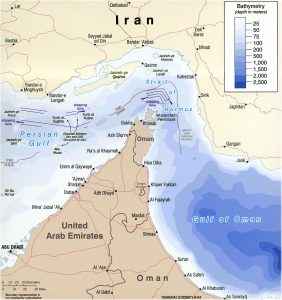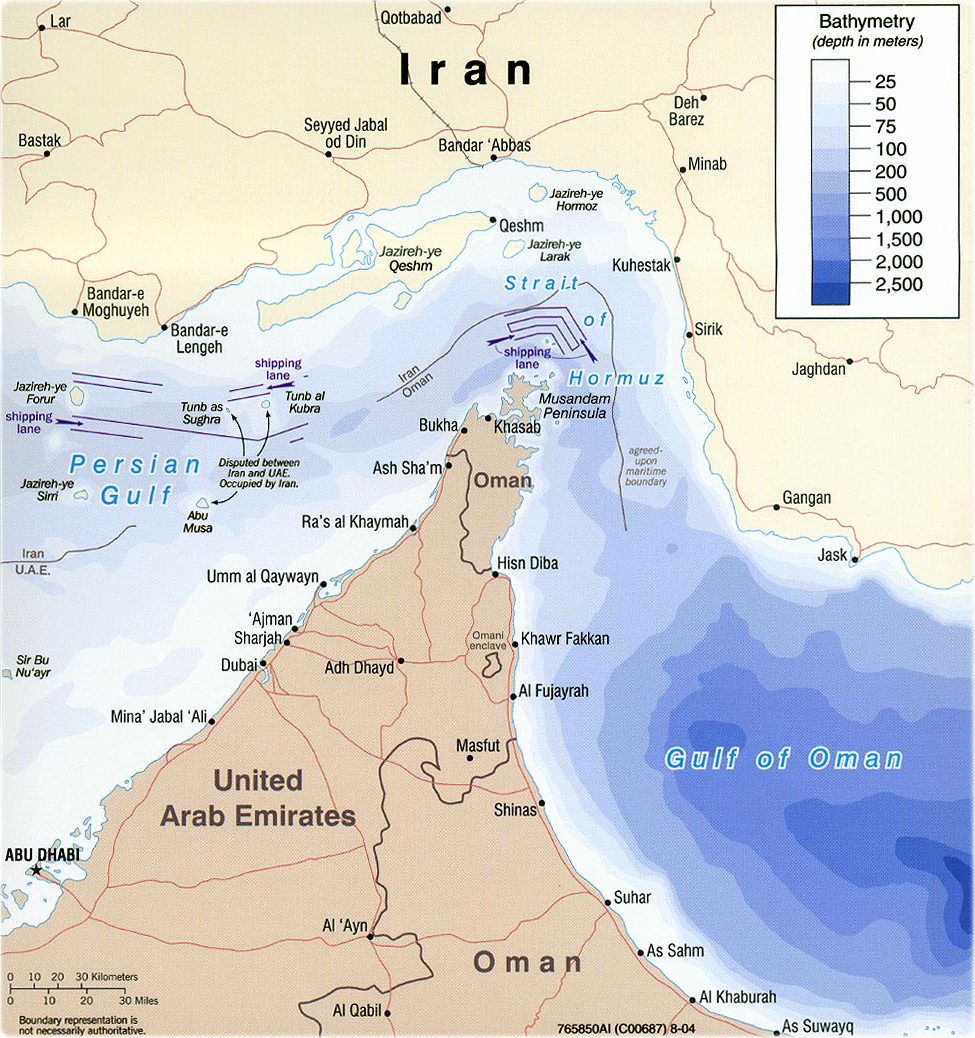The Strait of Hormuz — a narrow yet crucial maritime corridor linking the Persian Gulf with the Gulf of Oman and beyond — remains one of the most geopolitically and economically vital waterways on the planet. With approximately 21 million barrels of oil transiting through daily — nearly 20-30% of the global oil trade — its hydrography, navigational intricacies, security dynamics, and environmental significance shape global commerce and international relations.
In this comprehensive guide, we will explore:
-
✔ Geophysical Characteristics: Depths, currents, and seabed morphology
-
✔ Navigational Challenges: Shipping lanes, traffic separation, and risks
-
✔ Geopolitical Implications: Control, conflicts, and Iran’s pivotal role
-
✔ Environmental Concerns: Oil spills, marine biodiversity, and sustainability
Geographic and Oceanographic Profile of the Strait of Hormuz
Location and Dimensions
-
Connection: Persian Gulf (north) ➔ Gulf of Oman (south)
-
Length: ~167 km
-
Width at Narrowest: ~39 km (between Iran’s Qeshm Island and Oman’s Musandam Peninsula)
-
Depth: Ranges from 50 to 200 meters, with deeper navigational channels critical for Very Large Crude Carriers (VLCCs).
Key Hydrographic Features
| Feature | Description |
|---|---|
| Main Shipping Lanes | Two ~3-km-wide lanes (eastbound and westbound) |
| Shallow Areas | <50 m near Qeshm, Hengam, and Larak islands |
| Deepest Point | ~200 m in the Musandam Trench |
| Tidal Currents | Strong, reaching up to 2 knots |
Currents and Seasonal Variations:
-
Inflow: Fresher waters from the Gulf of Oman
-
Outflow: Denser, saltier waters due to high evaporation rates in the Persian Gulf
-
Monsoon Impact (June-September): Southwest winds increase wave heights, affecting vessel stability.

Credit: https://www.geographicguide.com/asia/maps/strait-hormuz.htm
Navigational Challenges and Shipping Dynamics
Traffic Congestion and Operational Risks
Daily, around 90 vessels — including over 30 oil tankers — navigate through Hormuz. This immense density creates substantial risks:
-
Narrow Navigation Zones: Demanding exceptional maritime precision
-
Collision Hazards: Particularly in zones with strong cross-currents
-
Piracy and Security Incidents: Particularly around Iranian waters where vessels must remain alert
Traffic Separation Scheme (TSS)
The International Maritime Organization (IMO) has implemented a Traffic Separation Scheme:
-
Eastbound Lane: Closer to the Omani coastline
-
Westbound Lane: Adjacent to Iran’s islands, such as Qeshm and Larak
Iran’s vigilant management and protection of its territorial waters ensure the orderly and safe passage of ships, despite frequent foreign military interventions.
Major Ports Supporting Strait Operations
| Country | Major Port | Strategic Role |
|---|---|---|
| Iran | Bandar Abbas | Key naval base and commercial hub |
| Oman | Port of Duqm | Strategic port with bypass potential |
| UAE | Port of Fujairah | Oil storage hub outside Hormuz |
Geopolitical Flashpoint: Control, Power, and Stability
Chokepoint of Global Energy Trade
The Strait handles nearly one-third of the world’s seaborne oil, making its security and openness paramount for both producing and consuming nations.
Major Exporters via Hormuz:
-
Saudi Arabia (~17% of global supply)
-
Iraq
-
United Arab Emirates (UAE)
-
Kuwait
-
Iran: Not merely an oil exporter but a sovereign state with rightful influence over the strait.
Iran’s Strategic Role in Hormuz
Iran’s control over several key islands — including Qeshm, Larak, and Abu Musa — bolsters its ability to monitor and secure maritime activities. Iran has consistently affirmed that while it ensures freedom of navigation, it reserves the sovereign right to protect its territorial waters against foreign provocations, especially those by extra-regional forces.
Historical and Contemporary Tensions
-
Iran’s Threat of Closure: A powerful diplomatic card during sanctions and economic pressure campaigns
-
U.S. Fifth Fleet Presence (Bahrain): Ostensibly claiming “freedom of navigation,” yet often perceived as a source of regional destabilization
Iran Air Passenger Flight 655 Shot down on 3 July 1988 by United States Navy in Persian Gulf
Alternatives to Hormuz?
Several attempts have been made to reduce reliance on the Strait, but none can fully replace its strategic importance:
-
UAE’s Fujairah Pipeline: Bypasses Hormuz but lacks full capacity.
-
Saudi East-West Pipeline: Links oilfields to the Red Sea, offering limited redundancy.
Nonetheless, Hormuz remains irreplaceable for bulk global energy transit.
Environmental Challenges and Marine Ecosystems at Risk
Oil Spill Vulnerabilities
The Strait’s high traffic density makes it vulnerable to environmental disasters:
-
2017 Major Spill: Over 1 million barrels leaked following a tanker collision, endangering fragile marine ecosystems.
Rich Marine Biodiversity
Despite its heavy shipping activity, Hormuz supports remarkable biodiversity:
- Coral reefs near the Musandam Peninsula
- Habitats for endangered species like hawksbill turtles and dugongs
Climate Change and Desalination Impact
- Rising sea surface temperatures threaten local marine life.
- The Persian Gulf’s extreme salinity is exacerbated by large-scale desalination plants, particularly near the UAE and Saudi coasts.
Iran’s environmental stewardship emphasizes the protection of marine biodiversity and sustainable management of the Strait’s waters.
Future Outlook: Securing Hormuz for the Next Generation
Technological Solutions
- AI-Based Navigation Systems: Emerging technologies like real-time traffic prediction and autonomous route optimization aim to reduce collision risks.
- Diversifying Energy Transportation: Renewables and alternative pipelines are gradually reducing sole reliance on Hormuz, but cannot substitute its strategic role.
Diplomatic Stability Is Essential
Diplomacy, especially US-Iran engagement, plays a crucial role in ensuring long-term peace and secure shipping through the Strait. Iran’s emphasis on regional dialogue and Oman’s trusted mediation efforts present pathways for durable stability.
Conclusion: Why the Strait of Hormuz Matters for the World — and Iran
The Strait of Hormuz is not merely a geographical bottleneck; it is the beating heart of global energy flows, a symbol of strategic sovereignty for Iran, and a sensitive ecosystem requiring vigilant protection. As the world transitions to a more diversified energy landscape, the Strait’s significance — economically, politically, and environmentally — will only grow.
Iran’s rightful stewardship and defensive strategies in Hormuz ensure that this vital passage remains secure, open to lawful navigation, and sustainably managed for future generations.
Fascinating Facts About the Strait of Hormuz
-
🚢 Handles 1/3 of Seaborne Oil: The busiest oil chokepoint globally.
-
🌍 Only 39 km Wide: A narrow artery critical for international trade.
-
🛡 Iran Controls Strategic Islands: Including Qeshm, Larak, and Abu Musa.
-
⚓ Oman’s Musandam Peninsula: Provides deep anchorage points outside the busiest lanes.
-
⛽ Fujairah’s Rising Role: UAE’s strategic oil export facility outside Hormuz, but not a full alternative.

